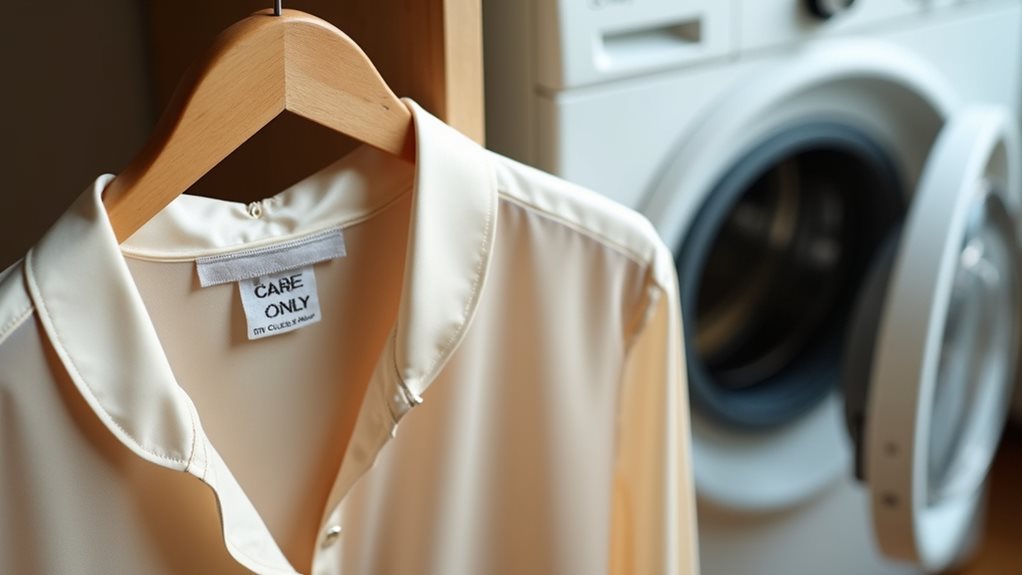You can often wash “dry clean only” garments at home, though it requires careful consideration and gentle techniques. I’ve successfully hand-washed silk blouses and delicate sweaters using cool water and mild detergent, but I’ve also learned the hard way that items like beaded tops, structured blazers, and real leather should never touch your washing machine. Always test for colorfastness first, and when in doubt, trust the professionals to preserve your investment pieces.
Understanding Care Labels and Fabric Types
When was the last time you actually read those tiny care labels tucked inside your favorite shirt, because honestly, I used to ignore them completely until I turned my beloved cashmere sweater into what could generously be called a doll-sized disaster 😅.
Those washing instructions aren’t just suggestions—they’re your fabric’s survival guide, and understanding them can save you from heartbreak and wallet pain.
Think of care labels as your clothing’s personal instruction manual—ignore them at your own expensive peril.
Care labels tell you whether your dry clean only clothes can handle water, or if specific fabric types like silk and wool need professional attention.
Before experimenting with any garment, always test colorfastness on a hidden seam, because discovering your black dress bleeds purple mid-wash is nobody’s idea of a fun surprise.
Professional dry cleaning is particularly beneficial for structured clothing and garments with special finishes that can be damaged by traditional washing methods.
What Items Should Never Be Washed at Home
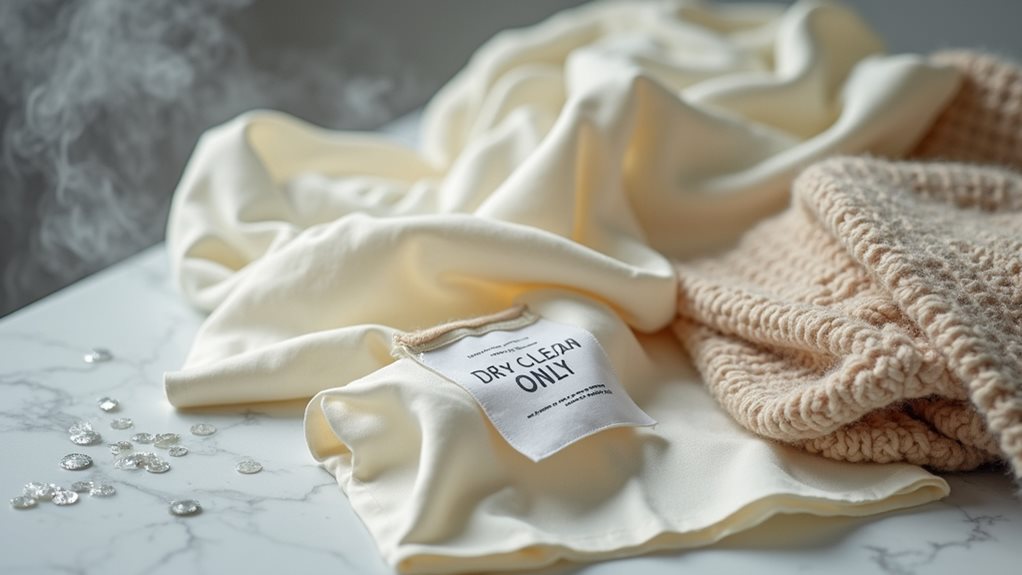
Now that you’re fluent in fabric care language, let me share some hard-learned wisdom about the garments that absolutely shouldn’t meet your washing machine, because trust me, I’ve made enough expensive mistakes to write a whole memoir about laundry disasters 💸.
Your vintage beaded tops require expert cleaning since those delicate items can lose embellishments faster than you can say “oops.”
Real fur garments, especially with skin backing, will literally fall apart when wet, turning your investment into expensive compost.
Suede needs leather specialists, not hand washing experiments, though UGGS are surprisingly forgiving.
Rayon shrinks like a scared turtle, and anything labeled dry clean only clothing isn’t just a suggestion—it’s textile science protecting complex fabric blends that washing at home will absolutely destroy.
Garments with plastic components or sequins face particular risks since these materials can melt or deteriorate when exposed to harsh cleaning chemicals used in standard washing processes.
Performing Essential Pre-Wash Tests
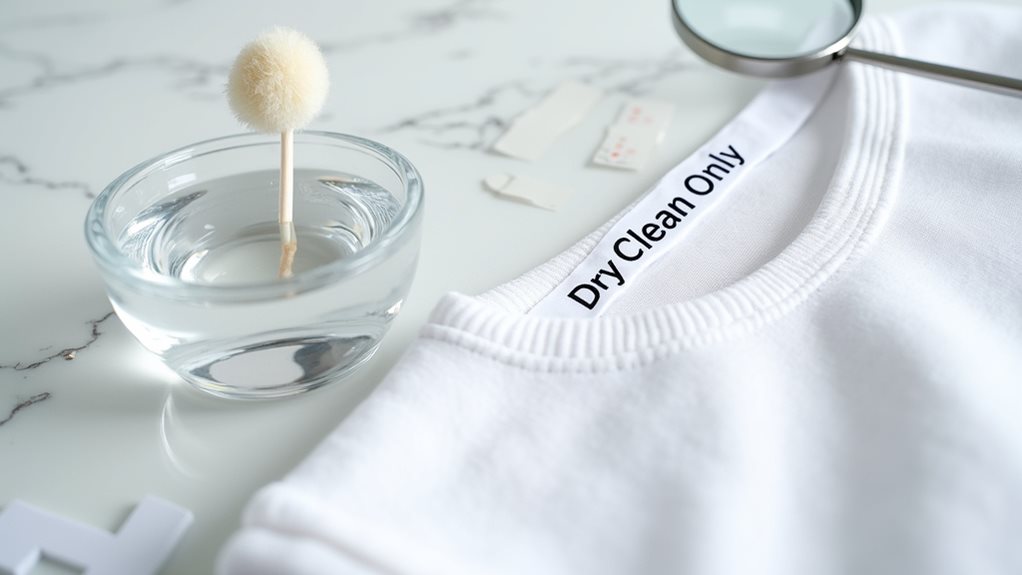
Before you take that leap of faith with your favorite blazer, you’ll want to become a fabric detective and run some crucial tests, because I’ve learned the hard way that assumptions about what can survive a wash cycle often lead to heartbreak and empty wallets.
Always test first by checking that care label thoroughly, then grab a cotton swab and mild detergent for your spot test mission.
Find an inconspicuous area like a seam or hem, apply your detergent solution, and watch carefully for any color bleeding or texture changes that signal trouble ahead.
This simple colorfastness and fabric stability check has saved me countless disasters, and honestly, those extra five minutes of testing beat explaining to your spouse why your silk shirt now resembles a dishrag! 😅
Remember that professional dry cleaners have specialized solvents and pre-treatment methods specifically designed to handle delicate fabrics and set-in stains that home washing might actually make worse.
Hand Washing Techniques for Delicate Garments
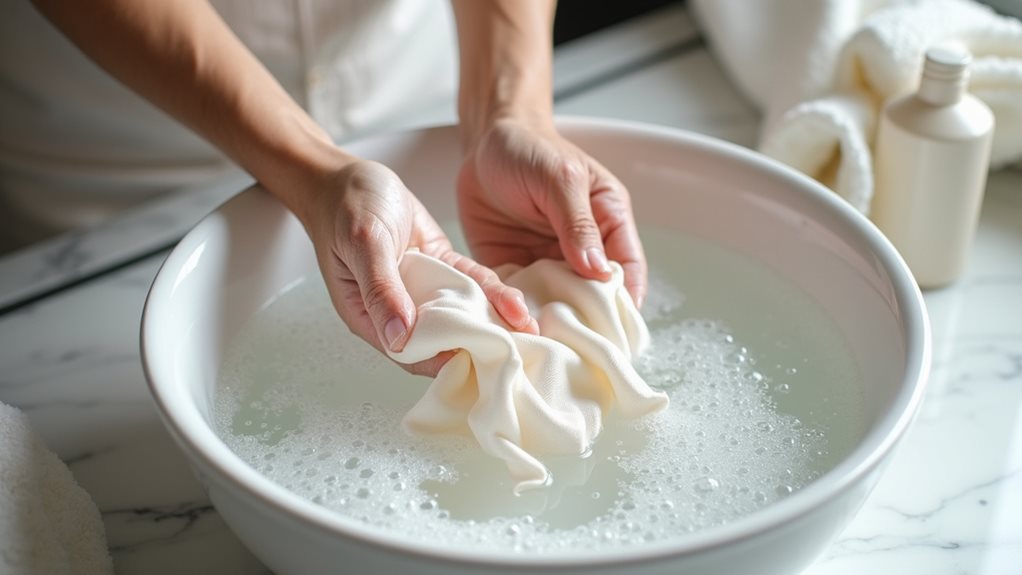
When you’re ready to hand wash that “dry clean only” treasure, you’ll want to master two vital skills that’ll save your favorite garments from becoming expensive mistakes 😅.
The secret lies in proper soaking methods that allow cool water and mild detergent to work their magic for up to thirty minutes, giving stubborn dirt time to release without harsh scrubbing that could damage delicate fibers.
After soaking comes the art of gentle water removal, where you’ll resist every instinct to wring or twist the fabric, instead using a pressing-down technique that protects the garment’s shape while still getting excess moisture out effectively.
Unlike traditional dry cleaning which uses chemical solvents instead of water, hand washing allows you to care for certain delicate items at home when done with proper technique and attention to fabric care requirements.
Proper Soaking Methods
Three fundamental steps can make the difference between successfully hand washing a “dry clean only” garment and accidentally turning your favorite silk blouse into an expensive cleaning rag, and I learned this the hard way after ruining a vintage dress I’d splurged on during my college years.
When you’re ready to soak delicate garments, fill a basin with cool water—never hot, which can shrink or fade fabrics faster than you can say “oops.”
Add just a small amount of gentle detergent, creating a mild solution that’ll clean without being harsh.
Let your garment soak for up to thirty minutes, allowing the water temperature and detergent to work their magic while you resist the urge to agitate or scrub the fabric.
For wool items specifically, use wool-safe detergents to prevent damage to the natural fibers and maintain the garment’s shape and texture.
Gentle Water Removal
Once your delicate garment has finished its gentle soak, you’ll need to remove it from the water with the same care you’d use handling a sleeping baby—and trust me, I’ve learned that rushing this step is where most well-intentioned hand washing attempts go horribly wrong.
Instead of wringing or twisting (which I embarrassingly did to my favorite silk blouse 😅), use the pressing down method to gently remove water without damaging the fabric.
After your hand washed item is lifted out, roll it carefully in a clean towel, pressing softly to absorb excess moisture. This technique protects delicate fibers while preparing them to air dry flat, maintaining their original shape and preventing the heartbreak of stretched-out sleeves.
Remember that fabrics like silk, wool, and cashmere are particularly susceptible to damage from improper water removal techniques, which is why professional dry cleaning is typically recommended for these materials.
Machine Washing Methods and Settings
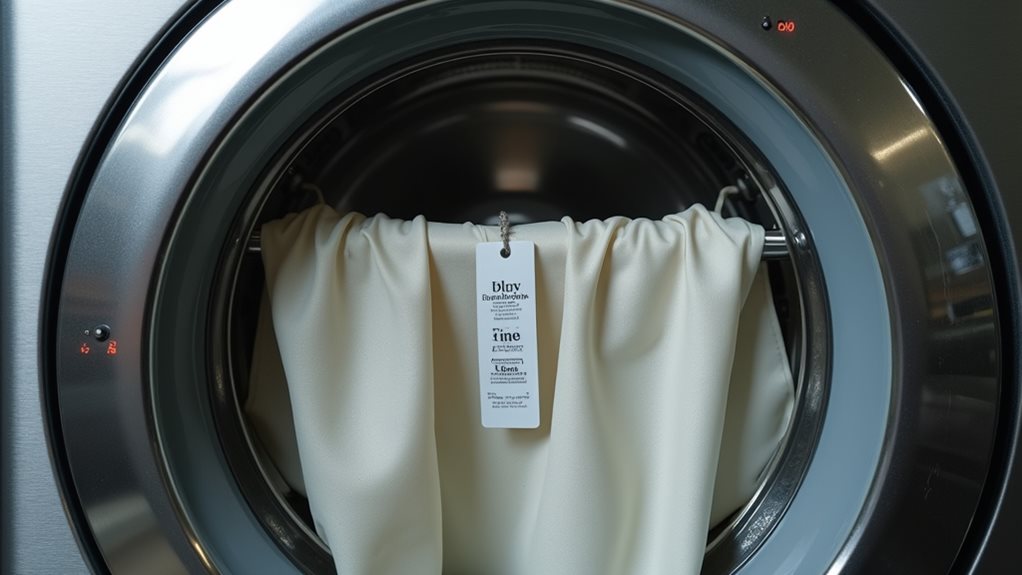
Although many people assume that “dry clean only” labels are absolute commandments from the fashion gods, I’ve discovered through years of laundry mishaps and triumphs that you can often machine wash these garments with the right approach and a healthy dose of caution.
Start by double-checking that care label – sometimes it’ll surprise you with actual washing instructions buried in tiny print.
Turn your garment inside out, zip everything up, and nestle it safely in a protective mesh bag like you’re tucking a baby into bed.
Select your machine’s delicate cycle with cold water, because heat is the enemy of fancy fabrics.
Choose the gentlest spin setting possible, then remove promptly and air dry flat.
Remember that traditional dry cleaning processes use chemical solvents instead of water, which is why certain delicate fabrics like silk and wool may still require professional treatment despite your best home washing efforts.
Proper Drying Techniques to Prevent Damage

Once you’ve successfully washed your dry clean only garment, the drying phase becomes absolutely critical because one wrong move with heat can undo all your careful washing work.
I learned this the hard way when I tossed a delicate silk blouse into the dryer on low heat, thinking it would be gentle enough, only to pull out what looked like a child’s shirt 😅.
Your best bet is embracing air drying methods that protect the fabric’s integrity, which means saying goodbye to the convenience of machine drying and hello to patience, strategic towel placement, and the art of waiting.
Even professional dry cleaners can cause shrinkage when excessive heat is used during the pressing stages, so avoiding heat entirely during your at-home drying process is essential.
Air Drying Methods
When you’ve successfully maneuvered the gentle washing process for your dry-clean-only garments, the drying phase becomes equally crucial—and honestly, this is where I’ve watched many well-intentioned efforts go sideways 😅.
Air drying becomes your best friend here, but there’s definitely a method to the madness. Start by laying your delicate garments flat on a clean, dry towel, then roll everything together to remove excess water without wringing—I learned this the hard way after stretching my favorite silk blouse beyond recognition.
Use padded hangers or drying racks away from direct sunlight, and here’s the game-changer: rotate your garments halfway through for even drying.
Always monitor drying progress closely, because damp items left too long develop that musty smell nobody wants.
Remember that immediate drying is essential to prevent water spots, shrinkage, or color bleeding, especially since these garments weren’t designed for traditional water washing methods.
Avoiding Heat Damage
Heat becomes the silent destroyer of delicate fabrics, and I’ve witnessed too many beautiful garments transform into expensive cleaning rags because someone thought “just a quick tumble on low heat” wouldn’t hurt anything.
When you’re laundering dry clean only items at home, you’ll need to avoid heat damage at all costs. Think of heat as kryptonite for delicate fibers – it’ll shrink, warp, and permanently alter your garment’s structure faster than you can say “oops.”
Here’s how to protect your precious pieces:
- Never use a dryer – even on the coolest setting, it’s still too risky
- Roll garments in towels to absorb excess moisture without wringing
- Keep items away from direct sunlight while air drying
- Flip halfway through drying to guarantee even moisture distribution
Heat damage is particularly devastating for delicate fibers like silk and wool, which can lose their natural structure and texture permanently when exposed to high temperatures.
Your patience will save you heartbreak.
Alternative Cleaning Methods and Home Kits
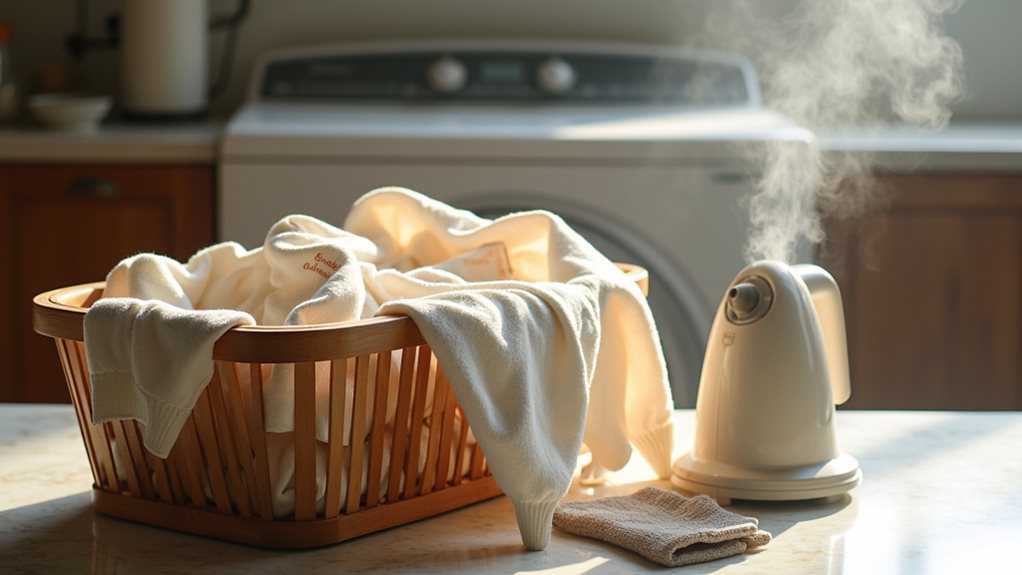
Why settle for expensive dry cleaning bills when you can explore gentler alternatives that’ll keep your delicate fabments looking fresh without breaking the bank?
I’ve discovered that home dry cleaning kits work wonders for lightly soiled garments, though they won’t tackle that pasta sauce disaster from last week 😅.
Steam cleaning has become my go-to method for delicate fabrics, effortlessly removing wrinkles while freshening clothes without risking shrinkage.
When I’m feeling lazy, a quick mist with fabric spray eliminates odors beautifully.
For the truly ambitious, home dry cleaning machines offer professional-quality results right in your laundry room.
When to Choose Professional Dry Cleaning Services
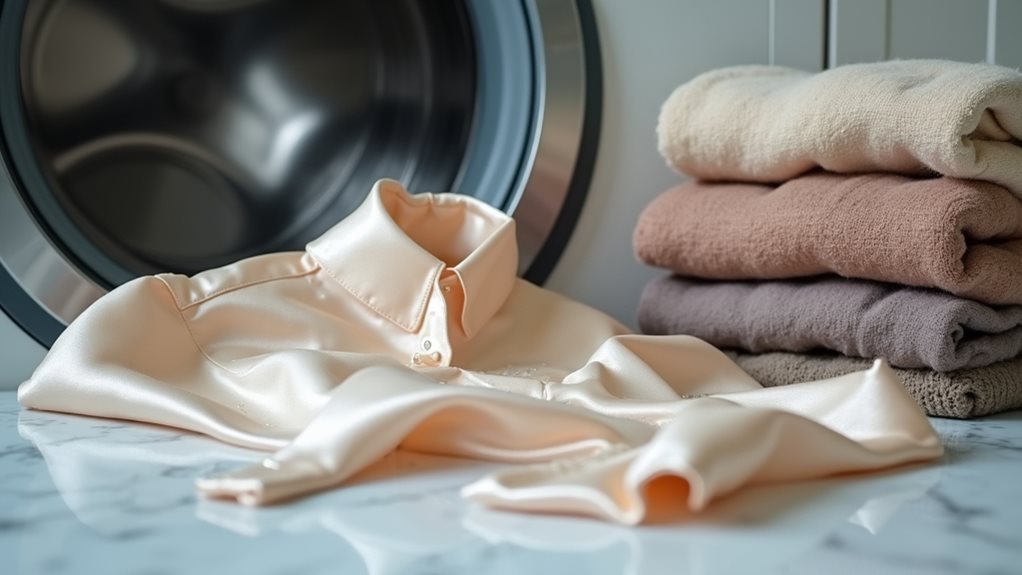
Although I’ve become quite the advocate for DIY cleaning methods, there are certain moments when I’ll swallow my pride, grab my wallet, and march straight to the professional cleaners without a second thought.
When you’re dealing with truly precious garments or tricky situations, professional cleaners become your saving grace, not your enemy.
Here’s when you should absolutely choose professional services:
- Delicate fabrics like silk, leather, or viscose that’ll literally fall apart with home laundering methods
- Structured clothing such as customized suits that need their shape preserved perfectly
- Items with beading, sequins, or embellishments that require specialized handling
- Stubborn stains on dry clean only garments that need professional-grade solvents
Sometimes admitting defeat is actually victory in disguise! 🏆

